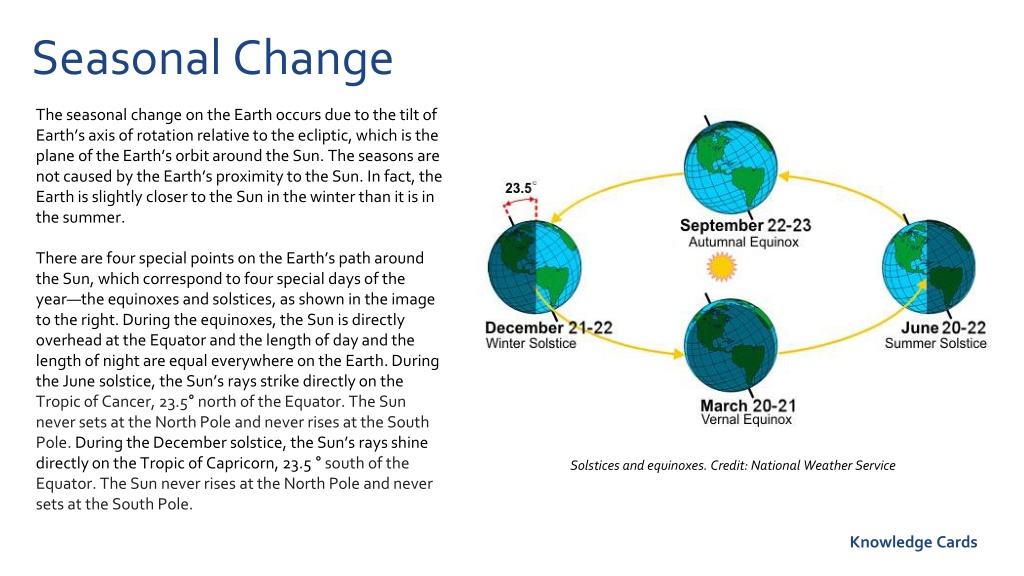Understanding the Impact of Seasonal Changes on Solar Energy Utilization
The Earth's tilt causes seasonal changes, affecting the Sun's path and daylight length. Solstices and equinoxes mark key points in the Earth's orbit. The Sun's path dictates daylight duration and solar radiation intensity, crucial for solar energy systems. Variations in daytime length influence solar energy generation, with locations like Boston experiencing longer days than Miami in summer. Solar energy efficiency relies on capturing sunlight at optimal angles influenced by the Sun's path.
Download Presentation

Please find below an Image/Link to download the presentation.
The content on the website is provided AS IS for your information and personal use only. It may not be sold, licensed, or shared on other websites without obtaining consent from the author. Download presentation by click this link. If you encounter any issues during the download, it is possible that the publisher has removed the file from their server.
E N D
Presentation Transcript
Seasonal Change The seasonal change on the Earth occurs due to the tilt of Earth s axis of rotation relative to the ecliptic, which is the plane of the Earth s orbit around the Sun. The seasons are not caused by the Earth s proximity to the Sun. In fact, the Earth is slightly closer to the Sun in the winter than it is in the summer. There are four special points on the Earth s path around the Sun, which correspond to four special days of the year the equinoxes and solstices, as shown in the image to the right. During the equinoxes, the Sun is directly overhead at the Equator and the length of day and the length of night are equal everywhere on the Earth. During the June solstice, the Sun s rays strike directly on the Tropic of Cancer, 23.5 north of the Equator. The Sun never sets at the North Pole and never rises at the South Pole.During the December solstice, the Sun s rays shine directly on the Tropic of Capricorn, 23.5 south of the Equator. The Sun never rises at the North Pole and never sets at the South Pole. Solstices and equinoxes. Credit: National Weather Service Knowledge Cards
Sun Path The previous image about solstices and equinoxes shows the relation between the Sun and the Earth as celestial bodies. The Sun path, on the other hand, shows the trajectory of the Sun relative to a location on the Earth during a day and throughout a year. In other words, the Sun path represents the motion of the Sun that an observer on the Earth perceives. Summer Except for the polar regions, the Sun always rises from the East and sets to the West. The difference is the height it appears to be at in the sky in different seasons. In the summer, the Sun is high in the sky. Whereas in the winter, the Sun is low in the sky. The image to the right, which was taken using long- exposure pinhole photography, captures the Sun s path for an entire year. Why is the Sun path important? The Sun path determines the length of daytime and the amount of daylight received along a certain latitude on a given day. A longer path leads to a longer day and a higher position results in stronger direct solar radiation. The relative position of the Sun is a major factor in the heat gain of buildings and in the performance of solar energy systems. Winter West East Solargraphy captures the Sun path across the sky throughout the year of 2014 in Budapest. Credit: Elekes Andor Knowledge Cards
Daytime Length Due to the seasonal change of the Sun path, we experience longer days in the summer than in the winter, as shown in the image to the right. But did you know that the day is actually longer in Boston (MA) than in Miami (FL) in the summer? This knowledge may be important for designing good engineering solutions that harness solar energy in the two areas effectively. Daytime refers to the time between sunrise and sunset during which a place on the Earth is illuminated by the Sun. The length of daytime depends on the time of the year and the latitude of the location. It is interesting to note that the polar regions are continuously illuminated by the Sun 24 hours in the summer. Note that daytime length is different from sunshine duration in which the Sun is clearly visible (e.g., in a cloudless sky). The sunshine duration cannot be longer than the daytime length, but is in general proportional to the daytime length. The output of a solar energy system is determined by the sunshine hours. The daytime length varies from season to season as the Sun path changes. Knowledge Cards
Projection Effect The intensity of solar energy that strikes a surface depends on the Sun s angle relative to the surface. Solar radiation is the strongest when the surface directly faces the Sun. As the angle between the sunlight beam and the surface normal (the direction perpendicular to the surface) increases, the intensity of solar radiation on the surface weakens. This is known as the projection effect, described by the following formula: Sun beam ? = ?maxcos? where Emaxis the maximum solar energy that hits the surface when it faces the Sun directly and is the angle between the sunlight beam and the surface normal. The image to the right illustrates this effect. Surface The projection effect is the main reason that solar radiation is the strongest at noon and in the summer. Although the image on this page uses a horizontal surface as an example for clarity, the project effect applies to surfaces in any direction. When we design a solar energy system, we have to consider not only the Sun path but also the orientation of the system. The projection effect on a horizontal surface. The sizes of the dashed areas represent the amounts of solar radiation the surface receives at the two angles. Knowledge Cards

























